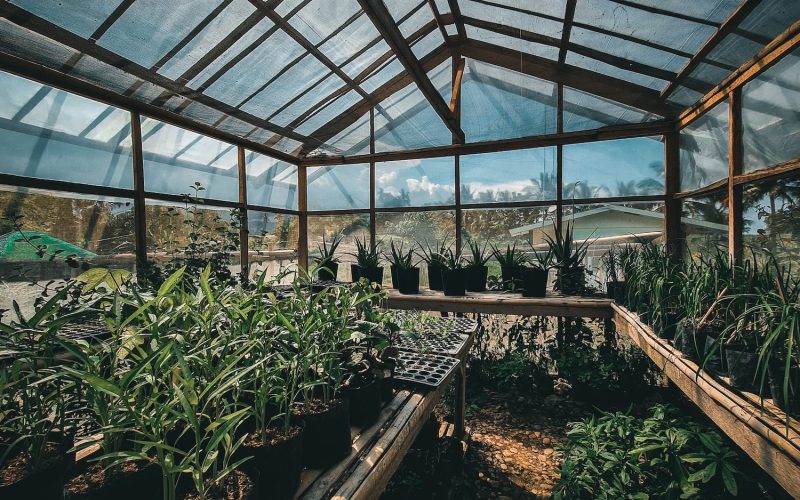A greenhouse can be an amazing addition for those passionate about gardening or farming.
But before you embark on your greenhouse journey, it’s important to understand what a greenhouse is and what purpose it serves.
What is a Greenhouse?
A greenhouse is a building or complex specifically designed for the growth and cultivation of plants.
It is built using transparent materials, like glass or plastic, which allows sunlight to enter while trapping heat inside.
This creates a controlled environment or microclimate ideal for plant growth.
The size of a greenhouse can vary greatly, from small backyard structures to large commercial complexes.
Some greenhouses are freestanding, while others are attached to houses or buildings, known as lean-to greenhouses.
There are also indoor greenhouses, also known as conservatories or sunrooms.
For more information on the types of greenhouses, refer to our article on what is a greenhouse.
The Purpose of a Greenhouse
The main purpose of a greenhouse is to create a controlled environment that is ideal for plant growth.
By manipulating factors such as temperature, humidity, and light exposure, a greenhouse allows you to grow a wide variety of plants that may not naturally thrive in your local climate.
This controlled environment also protects plants from harsh weather conditions, pests, and diseases, improving the overall yield and quality of the plants.
Greenhouses can be used for a variety of purposes, including growing vegetables, fruits, flowers, and exotic plants, as well as conducting scientific research.
Whether you’re a hobby gardener looking to extend your growing season, a farmer wanting to improve your yield or a scientist in need of a controlled environment for your experiments, a greenhouse can be an invaluable tool.
Understanding how a greenhouse works will help you maximize its potential and achieve your gardening goals.
In the following sections, we will delve deeper into the science behind greenhouses, the materials used in their construction, and how to maintain them.
This will give you a comprehensive understanding of how a greenhouse works and how you can best utilize it for your needs.
The Science Behind Greenhouses
Understanding the science behind greenhouses can help you effectively manage and optimize your greenhouse for plant growth.
This section will delve into the greenhouse effect and the role of sunlight, heat, and insulation in a greenhouse.
The Greenhouse Effect Explained
The greenhouse effect is the primary mechanism by which a greenhouse operates.
This phenomenon refers to the process where sunlight enters the greenhouse, warms the interior, and is trapped within, creating a warm and stable environment ideal for plant growth.
Sunlight, composed of various light waves, passes through the transparent walls and roof of the greenhouse.
The objects inside the greenhouse, including the plants and soil, absorb this light, which is then converted into heat.
Unlike the light waves, this heat cannot escape the greenhouse as easily, leading to a gradual buildup of warmth.
This is the greenhouse effect in action, and it’s how your greenhouse manages to stay warm, even when the external temperature drops. You can learn more about this in our article on what is a greenhouse.
Role of Sunlight, Heat, and Insulation
Sunlight plays a key role in the greenhouse environment. It is the primary source of heat and also provides the light necessary for photosynthesis, the process by which plants convert light into energy for growth.
Heat is essential for maintaining the warm temperatures that allow plants to grow year-round, regardless of the outdoor climate.
Managing heat effectively involves understanding how to heat a greenhouse in the colder months, which you can learn about in our how to heat a greenhouse guide, and how to cool a greenhouse when it becomes too hot, a topic covered in our how to cool a greenhouse article.
Insulation is crucial for preventing heat loss and maintaining consistent temperatures within the greenhouse.
The type of material your greenhouse is made of plays a significant role in its insulating properties.
Different materials have varying degrees of transparency and insulation, affecting how much sunlight enters the greenhouse and how well the heat is retained.
To understand more about these materials, refer to our article on what is a greenhouse made of.
In summary, a deep understanding of the science behind greenhouses and the role of sunlight, heat, and insulation can help you get the most out of your greenhouse, ensuring a thriving and productive environment for your plants.
Understanding Greenhouse Materials
A crucial aspect of understanding how a greenhouse works lies in the materials used to construct it.
The choice of materials can significantly impact the efficiency and effectiveness of a greenhouse.
This section will focus on the importance of transparency in greenhouse materials and the common materials used in its construction.
The Importance of Transparency
The primary reason greenhouses are effective is their ability to trap sunlight.
The transparent or semi-transparent materials allow the sunlight to enter, which is then absorbed by the plants and surfaces within the greenhouse.
This sunlight is converted into heat energy, warming the air inside the greenhouse.
If the material were not transparent, this process would not occur, and the greenhouse would not fulfill its purpose.
For a more in-depth explanation of this process, you can refer to our article on what is a greenhouse.
Moreover, transparency is crucial for photosynthesis, the process by which plants convert light energy into chemical energy.
Without sufficient light, your plants cannot grow and thrive. Therefore, transparency should be a key consideration when choosing materials for your greenhouse.
Common Materials Used in Greenhouse Construction
Various materials can be used to construct a greenhouse, each with its own set of advantages and disadvantages.
The choice of material often depends on factors such as your budget, the type of plants you wish to grow, and the climate in your area.
Let’s take a look at some of the most common materials used in greenhouse construction.
- Glass: Traditional greenhouses are often made of glass, which provides excellent transparency and longevity. However, glass can be expensive and fragile, making it less suitable for areas prone to severe weather.
- Polycarbonate: Polycarbonate is a type of plastic that is becoming increasingly popular in greenhouses. It’s more durable and insulating than glass while still providing good light transmission. However, it’s more expensive than other types of plastic.
- Polyethylene: Polyethylene is another type of plastic commonly used for greenhouses. It’s less durable than polycarbonate but is also less expensive, making it a good option for temporary or seasonal greenhouses.
| Material | Pros | Cons |
|---|---|---|
| Glass | Excellent transparency, Longevity | Expensive, Fragile |
| Polycarbonate | Durable, Good insulation | More expensive than other plastics |
| Polyethylene | Affordable, Suitable for temporary use | Less durable |
For more information about choosing the right material for your greenhouse, you can visit our article about what is a greenhouse made of.
Understanding the materials used in the construction of a greenhouse is an important step in maximizing its effectiveness and longevity.
By choosing the right materials, you can create a conducive environment for your plants to grow and thrive, regardless of the external weather conditions.
Greenhouse Climate Control
One of the essential elements to understand about how a greenhouse works revolves around its climate control mechanisms.
This includes temperature regulation, humidity and ventilation systems, and light and shade control.
Temperature Regulation in a Greenhouse
In managing a greenhouse, temperature regulation is crucial. You need to maintain an optimal temperature that supports plant growth.
This involves heating the greenhouse during colder months and cooling it when the temperature gets too high.
You can heat the greenhouse using different heating systems, like electric or gas heaters.
Distributing the heat evenly across the greenhouse is important to ensure all plants benefit.
For more information on heating a greenhouse, check out our article on how to heat a greenhouse.
On the other hand, cooling a greenhouse can be achieved through ventilation, shade cloths, or evaporative cooling systems.
For further details, refer to our guide on how to cool a greenhouse.
Humidity and Ventilation Systems
Maintaining the right level of humidity is just as important as temperature regulation.
Too much humidity can lead to fungal diseases, while too little can cause dehydration in plants.
Ventilation systems play a significant role in controlling humidity levels. They help to circulate air and reduce the buildup of excess moisture.
There are two types of ventilation systems: natural and mechanical. Natural ventilation utilizes wind and temperature differences, while mechanical ventilation uses fans and vents.
| Ventilation Type | Application |
|---|---|
| Natural Ventilation | Ideal for small-scale greenhouses |
| Mechanical Ventilation | Suitable for large commercial greenhouses |
Light and Shade Control
Finally, controlling the amount of light that enters the greenhouse is another key aspect of greenhouse management.
Plants need light for photosynthesis, but too much can be harmful.
To control light levels, you can use shade cloths or install an adjustable shading system.
This allows you to increase or decrease the amount of light as needed.
| Light Control Method | Application |
|---|---|
| Shade Cloth | Can be used in any size of greenhouse |
| Adjustable Shading System | Ideal for large-scale commercial greenhouses |
Climate control is a fundamental part of greenhouse management.
By understanding how to regulate temperature, humidity, and light levels, you can create the ideal conditions for your plants to flourish.
For more tips on how to maintain your greenhouse, visit our other articles on what is a greenhouse and what is a greenhouse made of.
Plant Growth in a Greenhouse
Understanding how a greenhouse works is crucial for its construction and maintenance and vital for the growth and well-being of the plants inside.
This section will discuss the benefits of a controlled environment and the common plants you can grow in a greenhouse.
The Benefits of a Controlled Environment
A greenhouse provides a controlled environment that can be optimized for the growth of a variety of plants.
This controlled environment brings several advantages:
- Extended Growing Season: Greenhouses allow you to extend the growing season of plants by providing a warm and stable environment, irrespective of the outside weather conditions.
- Protection from Pests and Diseases: The enclosed structure of a greenhouse helps protect your plants from pests and diseases.
- Variety of Crops: With the ability to control temperature, humidity, and light, you can grow a wider variety of plants, including those that might not naturally grow in your region.
- Improved Yield: The optimal conditions within a greenhouse can lead to improved plant growth and higher yield.
Common Plants Grown in Greenhouses
The controlled environment in a greenhouse allows you to cultivate a variety of plants throughout the year.
Some of the common plants grown in greenhouses include:
- Vegetables: Tomatoes, cucumbers, lettuce, and peppers are some of the vegetables commonly grown in greenhouses. These plants thrive in the warm, stable conditions that a greenhouse provides.
- Herbs: Herbs such as basil, chives, parsley, and dill can be grown year-round in a greenhouse. The controlled environment allows for a steady supply of fresh herbs.
- Flowers: Many types of flowers, including roses, orchids, lilies, and geraniums, are grown in greenhouses. The ability to control light, temperature, and humidity makes it possible to grow these flowers throughout the year.
| Plant Type | Examples |
|---|---|
| Vegetables | Tomatoes, Cucumbers, Lettuce, Peppers |
| Herbs | Basil, Chives, Parsley, Dill |
| Flowers | Roses, Orchids, Lilies, Geraniums |
Remember, the key to successful plant growth in a greenhouse is understanding how a greenhouse works and adjusting the environment, such as temperature and humidity, according to the needs of the plants.
Always ensure you have the right temperature regulation, humidity control, and light conditions for your growing plants.
Maintaining a Greenhouse
Understanding how a greenhouse works is just the first step in your greenhouse journey.
The real test lies in maintaining it efficiently for optimal plant growth. This involves regular checks and balances and troubleshooting any common issues.
Regular Greenhouse Checks and Balancing
To keep your greenhouse running smoothly, you should perform regular checks.
This involves monitoring temperature levels, maintaining humidity, and ensuring that your ventilation systems work correctly.
- Temperature: A greenhouse’s temperature needs to be kept within a specific range appropriate for the plants you are growing. On average, a temperature between 80-85°F during the day and 60-75°F at night is ideal for most plants. You may need to use heaters or cooling systems to maintain this range. Refer to our articles on how to heat a greenhouse and how to cool a greenhouse for detailed guidance.
- Humidity: Greenhouses should maintain a relative humidity level between 50-70%. High humidity can lead to plant diseases, while low humidity can lead to water loss in plants.
- Ventilation: Regular checks on your ventilation systems are crucial as they help control both temperature and humidity levels.
| Check | Ideal Range |
|---|---|
| Temperature | 80-85°F (day), 60-75°F (night) |
| Humidity | 50-70% |
| Ventilation | Functional |
Common Issues and How to Troubleshoot Them
Despite regular checks and maintenance, you may encounter certain issues in your greenhouse.
Here are some common ones and how you can troubleshoot them:
- 1. Pest Infestation: Use natural pest control methods or organic pesticides to treat the infestation. Regular cleaning of the greenhouse can also help prevent pests.
- 2. Plant Diseases: Regularly inspect your plants for any signs of disease. If you notice any, isolate the affected plants to prevent the disease from spreading.
- 3. Inadequate Lighting: Ensure that your greenhouse is receiving enough light. You may need to use artificial lighting during the winter months or for plants that require a lot of light.
- 4. Temperature Fluctuations: Regularly monitor the temperature in your greenhouse. If it’s too hot, consider installing shade cloths or using a cooling system. If it’s too cold, you may need to use a heater or increase insulation.
| Issue | Solution |
|---|---|
| Pest Infestation | Natural pest control, regular cleaning |
| Plant Diseases | Isolate affected plants |
| Inadequate Lighting | Use artificial lighting if necessary |
| Temperature Fluctuations | Use cooling systems or heaters, adjust insulation |
Remember, regular maintenance is not only about fixing problems but also about preventing them.
By closely monitoring your greenhouse environment, you can ensure your plants thrive and reap the benefits of your hard work.
For more on the operation and maintenance of a greenhouse, refer to our detailed articles on what is a greenhouse and what is a greenhouse made of.








